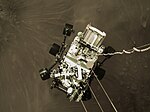astro.wikisort.org - Asteroid
2019 XS is a small Apollo near-Earth asteroid discovered on 2 December 2019 by the Mount Lemmon Survey in Arizona, United States.[2] It passed 1.493 lunar distances (574,000 km; 357,000 mi) from Earth on 9 November 2021 at 03:48 UTC, after which observations were checked by the International Asteroid Warning Network for timing and astrometric accuracy.[7][8][9] During the close pass, the asteroid trailed across the far Southern Hemisphere to the Northern Hemisphere and reached a peak apparent magnitude of 13. A total of 957 observations were collected by Minor Planet Center as part of the International Asteroid Warning Network's campaign.[10]
 Goldstone radar images of 2019 XS taken on 11 November 2021 | |
| Discovery [1][2] | |
|---|---|
| Discovered by | MLS |
| Discovery site | Mt. Lemmon Obs. |
| Discovery date | 2 December 2019 |
| Designations | |
MPC designation | 2019 XS |
Alternative designations | C1HDFQ2 [3] |
Minor planet category | NEO · Apollo [4] |
| Orbital characteristics [4] | |
| Epoch 21 January 2022 (JD 2459600.5) | |
| Uncertainty parameter 0 | |
| Observation arc | 21.68 yr (7,919 days) |
| Earliest precovery date | 4 April 2000 |
| Aphelion | 1.332 AU |
| Perihelion | 0.6766 AU |
Semi-major axis | 1.005 AU |
| Eccentricity | 0.3264 |
Orbital period (sidereal) | 1.01 yr (367.74 days) |
Mean anomaly | 140.339° |
Mean motion | 0° 58m 44.218s / day |
| Inclination | 4.447° |
Longitude of ascending node | 49.483° |
Argument of perihelion | 250.285° |
| Earth MOID | 0.004003 AU (598,800 km) |
| Physical characteristics | |
Mean diameter | ~70 m [5] |
Synodic rotation period | 2.35±0.01 h[6] 3.01±0.01 h[6] |
Absolute magnitude (H) | 23.96±0.33 [4] 23.87 [1] |
2019 XS is well-observed with a long observation arc of over 21 years, enough to distinguish subtle changes in its orbit over time due non-gravitational acceleration by the Yarkovsky effect.[4][10] Highly precise radar observations by NASA's Goldstone Solar System Radar on 11 November 2021 have significantly constrained the asteroid's orbit and 2021 close approach distance to within a few kilometres.[4] Radar imaging has shown that the asteroid is roughly 70 m (230 ft) in diameter, with a rotation period around 3 hours.[5]
Continuous photometric observations by the Center for Solar System Studies in Landers, California show an irregular light curve for 2019 XS, signifying that the asteroid is in a tumbling rotation state.[6] The light curve of 2019 XS appears to display two overlapping periods of 2.35 and 3.01 hours, which could possibly be associated with the asteroid's rotation and precession.[6]
See also
- 2012 TC4, another near-Earth asteroid with a dedicated IAWN timing campaign
References
- "2019 XS". Minor Planet Center. International Astronomical Union. Retrieved 12 October 2021.
- "MPEC 2019-X47 : 2019 XS". Minor Planet Electronic Circular. Minor Planet Center. 4 December 2019. Retrieved 12 October 2021.
- "2019 XS". NEO Exchange. Las Cumbres Observatory. 5 October 2021. Retrieved 12 October 2021.
- "JPL Small-Body Database Browser: (2019 XS)" (2021-12-09 last obs.). Jet Propulsion Laboratory. Retrieved 7 January 2022.
- Benner, Lance A. M. "Goldstone Radar Observations Planning: Orpheus, 2004 UE, 2019 XS, and 2010 VK139". Jet Propulsion Laboratory. California Institute of Technology. Retrieved 12 November 2021.
- Warner, Brian D.; Stephens, Robert D. (April 2022). "Near-Earth Asteroid Lightcurve Analysis at the Center for Solar System Studies: 2021 October-December". The Minor Planet Bulletin. 49 (2): 83–89. Bibcode:2022MPBu...49...83W.
- "2019 XS: Timing Assessment". International Asteroid Warning Network. 3 October 2021. Retrieved 12 October 2021.
- "MPEC 2021-T79 : International Asteroid Warning Network (IAWN) Timing Campaign". Minor Planet Electronic Circular. Minor Planet Center. 5 October 2021. Retrieved 12 October 2021.
- "MPEC 2020-V63 : 2019 XS". Minor Planet Electronic Circular. Minor Planet Center. 10 November 2020. Retrieved 12 October 2021.
- Farnocchia, Davide; Reddy, Vishnu; Bauer, James M.; Warner, Elizabeth M.; Micheli, Marco; Payne, Matthew J.; et al. (July 2022). "International Asteroid Warning Network Timing Campaign: 2019 XS". The Planetary Science Journal. 3 (7): 13. Bibcode:2022PSJ.....3..156F. doi:10.3847/PSJ/ac7224. 156.
External links
- 2019 XS: Timing Assessment, International Asteroid Warning Network, 3 October 2021
- Goldstone Radar Observations Planning: Orpheus, 2004 UE, 2019 XS, and 2010 VK139, Lance A. M. Benner, Jet Propulsion Laboratory
- 2019 XS at NeoDyS-2, Near Earth Objects—Dynamic Site
- Ephemeris · Obs prediction · Orbital info · MOID · Proper elements · Obs info · Close · Physical info · NEOCC
- 2019 XS at ESA–space situational awareness
- 2019 XS at the JPL Small-Body Database
Другой контент может иметь иную лицензию. Перед использованием материалов сайта WikiSort.org внимательно изучите правила лицензирования конкретных элементов наполнения сайта.
WikiSort.org - проект по пересортировке и дополнению контента Википедии


